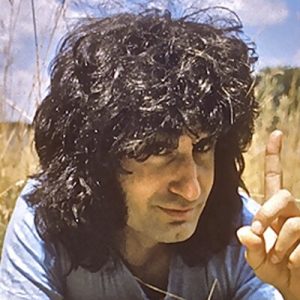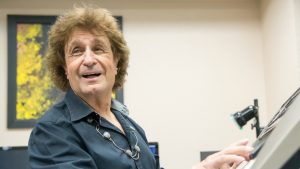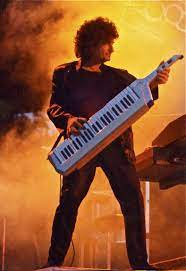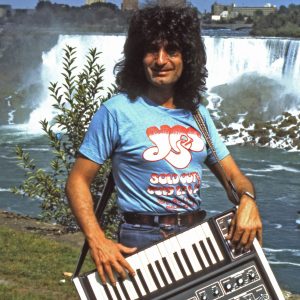HIT CHANNEL EXCLUSIVE INTERVIEW: June 2014. We had the great honour to talk with a great keyboardist: Patrick Moraz. He was a member of YES from 1974 to 1976 and of The Moody Blues from 1980 to 1990, though, technically, he had been doing two Tours with them in ‘78 and ‘79. Previously he had formed Mainhorse with Jean Ristori and Refugee with Lee Jackson and Brian Davison, former members of The Nice. He has an interesting and prolific solo career and he has recorded with Chick Corea and Bill Bruford (Yes, King Crimson). This year, he took part in the “Cruise to The Edge”. Read below the very interesting things he told us:
 Was it an interesting experience to record “L.A Woman” with Jimi Jamison (Survivor) and Ted Turner (Wishbone Ash) for the tribute album, “Light My Fire – A Classic Rock Salute to The Doors”?
Was it an interesting experience to record “L.A Woman” with Jimi Jamison (Survivor) and Ted Turner (Wishbone Ash) for the tribute album, “Light My Fire – A Classic Rock Salute to The Doors”?
It was a great experience because it made me rediscover The Doors, of whom I knew the music before and I was asked to do the keyboard part without copying Ray Manzarek. The record company wanted us to keep some of the original passages, the instrumental passages and so on and I had fun doing it. I did all the keyboard parts: you know, solos on the keyboards, on the electric pianos and searching sounds. I think it was my idea to have the door opening and shutting in the very beginning of the track. I did all the piano lines and so on. I had a very good rapport with Billy Sherwood, whom I know personally of course, because he was also in a group I used to be a member of as well, YES. I was having a lot of fun experimenting with the song they provided me, with the basic backing track. It was a very rich sonic experience for me to do that. The singer Jimi Jamison did a very good job, as well as Billy on bass and the guitarist, Ted Turner, and the drummer, Scott Connor, as well. I just heard it for the first time yesterday (ed: 15 June), would you believe? It’s a really-really good surprise.
What are the current projects you are involved in?
I’m currently in Los Angeles to finish a big production. It is for an excellent drummer and very good friend of mine, Greg Alban. I composed and arranged all the music and played keyboards and acoustic piano. It also features some excellent musicians such as bassists John Avila, Patrick Perrier and Matt Malley as guest sitarist, as well as percussionist Lenny Castro. I also have been working on the continuation of my own solo album for which I am in the finishing process right now.
Did you enjoy the “Cruise to the Edge”?
We had a fantastic time. I was very happy to be part of the “Cruise to the Edge”. In addition to my two concerts with electronic keyboards and piano, I was asked to do an additional concert, playing on an acoustic grand piano exclusively. I also did a Master-Class which was a lot of fun! It was full of people and the cruise was excellent. I was even able to do a song from the YES repertoire of the time, “Soon” with Annie Haslam, a very good friend of mine, who is, as you know, the lead singer of Renaissance. I think she did a fantastic job, because we only rehearsed a couple of times. It was a very impromptu version like that, but we really enjoyed it.
 How did it happen to join YES? Why did you audition on Vangelis’ keyboards?
How did it happen to join YES? Why did you audition on Vangelis’ keyboards?
(Laughs) Actually, it’s funny that you say that, because I knew Vangelis’ music even before Refugee and before YES. I used to know him when he was a part of the band Aphrodite’s Child. I always liked his music very much, but he was actually auditioning for YES, for the part of the keyboard player. At the time, I think he had even his keyboards brought to the YES place where they were rehearsing. So, when I was asked to come and see them rehearse, and eventually there was a good audition, these were the keyboards which were in the place. There were a bit out of tune because I think they hadn’t been there for two days or whatever, so I had to tune them first. The sound of the keyboards was very-very good and the rest is History (laughs).
Why Vangelis didn’t join YES?
I don’t know. YES is a very controlled kind of musical environment and they have very-very precise parts and a lot of spontaneity as well. You know the two characters: some of the YES members at the time and Vangelis, probably didn’t get along in terms of the music, I think. That afternoon, it was Wednesday afternoon, I went at 2pm and I left at 4 o’clock, I think. We played, we jammed and I composed the introduction to “Sound Chaser”. I think what happened is: Vangelis was very fortunate because by not being with YES, he was able to concentrate on his own music and also compose scores for big movie productions. He did a fantastic job! He is a great composer and I respect his music immensely.
Are you proud of your involvement in “Relayer” (1974) album of YES?
Yes, of course! What I can say about my music and my involvement in YES, in Refugee, in The Moody Blues and later, as well as with my own solo music is: I don’t regret one note I have played in my life as a musician.
 You had started the writing for “Going for the One” (1977) when you were asked to leave YES. Did you expect that you would leave YES in late 1976?
You had started the writing for “Going for the One” (1977) when you were asked to leave YES. Did you expect that you would leave YES in late 1976?
No, absolutely not. Because we had already started to compose, rehearse and even record for “Going for the One”. I was with YES for 2 ½ years. And not only we recorded the whole album of “Relayer”, but I had to learn in less than six weeks -in the beginning of August and in September of ’74, which is 40 years ago- the seven previous albums that they had composed. Then, when we started to go on the road, the things went extremely well. We were playing to sold-out audiences in the United States and in England as well. In ’75 I contributed also to Steve Howe’s first solo album and I contributed to Chris Squire’s solo album (ed: “Fish Out of Water”). I arranged the orchestra for Steve Howe’s first album, “Beginnings”. Apart from that, we had also all together decided to think and talk about the new album, the next album which was made to be “Going for the One” and we had prepared the material of “Awaken” that later appeared on “Going for the One”. I remember also that “Parallels” was created at that time during our interactive rehearsals.
Was the writing and the recording process of your solo album “Story of I” (1976) a liberating experience for you?
It was a fantastic experience to be able to do this, because having already finished the second tour in the summer of ’75, I had the opportunity to travel for the first time to South America and I was able to create something which has been labeled as one the very first “world music” albums, because I was using Brazilian percussionists and some of the voices I orchestrated in a symphonic way. When you mentioned the title: “The Story of I”, I have to tell you that at the time, my idea was to call the album simply “i”. And the record company told me: “What you want to do with a logo and a letter? We will not able to sell the music of the album because they will not recognize it. And because you wrote “The Story of I” why don’t you call it “i or a.k.a” -which means also known as- “The Story of I”. The original title is “i”. And of course nowadays we have iPhones and iPods and iMac and everything (laughs).
Why the recordings for The Moody Blues’ “Long Distance Voyager” (1981) took so long?
Well, I can tell you that it certainly didn’t take so long because of me (laughs). The first thing on the record was from an introduction I composed in my own studio.
Then, when Justin (ed: Hayward) played “The Voice”, the first song of “Long Distance Voyager”, I remember it very well because it was a Tuesday afternoon! We had started that day between 1 and 2 pm. He played the song and then the producer, Pip Williams, asked me, as I had all my keyboards ready, that I needed to turn-on the sound in the studio. It was a very interesting studio! The “control-room” looked like some aspect of inside a spaceship at the time.
 I did my parts on “The Voice” during that afternoon as well as all the melodic lines over the basic chords. I had played my basic parts on the keyboards, while Justin played his on an acoustic guitar. I did my overdubs immediately after that with the Moog synthesizers and some of the equipment, i.e. the famous “Mellotron” I was using at the time. I don’t know why the album took so long, but there is a saying in English: “How long is a piece of string?” Is it necessary that a work of art be assessed in terms of the time it took to make it, or is it more important and vital in terms of its creativity?
I did my parts on “The Voice” during that afternoon as well as all the melodic lines over the basic chords. I had played my basic parts on the keyboards, while Justin played his on an acoustic guitar. I did my overdubs immediately after that with the Moog synthesizers and some of the equipment, i.e. the famous “Mellotron” I was using at the time. I don’t know why the album took so long, but there is a saying in English: “How long is a piece of string?” Is it necessary that a work of art be assessed in terms of the time it took to make it, or is it more important and vital in terms of its creativity?
I have always considered that, as far as I am concerned, -and this is my own quote – : “The Epitome of Creativity lays in the state of dynamic tension, and balance, between extreme forces in opposition”. (©PM1984)
I think creativity has to do with two vital ingredients : It has to do with spontaneity in real time, the free part of creativity which comes from the true inspiration of the soul, and what I would call the “Poetry of Creation” and then, there are the tools of the Trade, which can take sometimes a very long time to use and help materialize the finished product, and what I would call the “Prose of Fabrication”, especially when you work with a group!
Also don’t forget that they themselves although they had been already on the road for two years, in the beginning of 1980, had only really recorded one other album before, after about five years of absence. But anyway, I think “Long Distance Voyager” was a very good album and helped in the regeneration of the band. I am glad and proud to have been able to contribute to it.
What happened to your score for “Predator” (1987)? You even met Arnold Schwarzenegger on the set of “Predator” in Mexico!
I was originally contracted to do the film score for “Predator”. Joel Silver, the producer invited me to Mexico to meet with everybody. Joel Silver was the main producer. The day I arrived in Mexico, actually I had just finished the work I did for the film “The Stepfather”, but “Predator” was already being filmed when I was contacted to do the work on “Predator”. But anyway, I went to Mexico, I met with everybody. It was fantastic, I even remember Schwarzenegger listening to my headphones in the jungle (laughs). And somebody was taking pictures of us. I did the film score. I came back to Los Angeles, I worked on it. That was in the second part of 1986, but in the early ’87 when the film was supposed to be completely rough and ready to finish the recording, I hadn’t seen it because I was obliged to go with The Moody Blues to Australia and I didn’t have the opportunity to accept the request of Joel Silver who wanted the film to go on. The Moody Blues were about to begin a big tour in Australia and I was already playing with the Moodies for 9 years and I didn’t want to leave the band before a so important tour. So, I decided to tour in Australia with The Moody Blues and Alan Silvestri did the final score for “Predator”. He did a fantastic job! In the ‘80s he was one the most famous film score composers (“Back to the Future”). I don’t think anybody could do it better than Alan Silvestri.
 Do you consider your work with Bill Bruford as one of the highlights of your career?
Do you consider your work with Bill Bruford as one of the highlights of your career?
I wouldn’t say that this is the highlight of my career! But I really enjoyed playing with him. Funny how, would you believe that yesterday, (ed: 15 June) I was invited to a dinner and somebody attracted my attention on a Youtube video of a concert I did with Bill in 1983 at The Roxy Theatre in Los Angeles. I had never seen it and although the sound is not perfect, the material we were playing at the time was quite adventurous and the idea was to do an acoustic duo, the Moraz/Bruford duo and to be without complications, without any electronics, at least for the first album. That’s why we did “Music for Piano and Drums” first. – The title I chose, BTW:-) I really-really enjoyed it and I think it’s one of my musical highlights, one of them, Yes!
A huge “THANK YOU” to Patrick Moraz for his time and to Billy James for his valuable help.
Please check out: www.patrickmoraz.com

